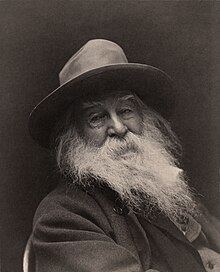
Brooklyn is a borough of New York City, coextensive with Kings County, in the U.S. state of New York. Kings County is the most populous county in the State of New York, and the second-most densely populated county in the United States, behind New York County (Manhattan). Brooklyn is also New York City's most populous borough, with 2,736,074 residents in 2020.

Kreuzberg is a district of Berlin, Germany. It is part of the Friedrichshain-Kreuzberg borough located south of Mitte. During the Cold War era, it was one of the poorest areas of West Berlin, but since German reunification in 1990, it has become more gentrified and is known for its arts scene.
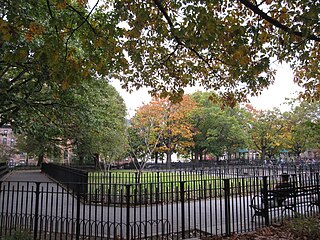
Clinton Hill is a neighborhood in north-central Brooklyn, a borough of New York City. It is bordered by the Brooklyn Navy Yard and the Brooklyn-Queens Expressway to the north, Williamsburg to the northeast, Classon Avenue and Bedford–Stuyvesant to the east, Atlantic Avenue and Prospect Heights to the south and southwest and Vanderbilt Avenue and Fort Greene to the west.
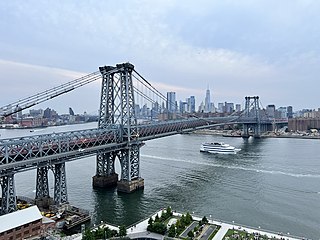
The Williamsburg Bridge is a suspension bridge in New York City across the East River connecting the Lower East Side of Manhattan at Delancey Street with the Williamsburg neighborhood of Brooklyn at Broadway near the Brooklyn-Queens Expressway. Completed in 1903, it was the longest suspension bridge span in the world until 1924.

Williamsburg is a neighborhood in the New York City borough of Brooklyn, bordered by Greenpoint to the north; Bedford–Stuyvesant to the south; Bushwick and East Williamsburg to the east; and the East River to the west. As of the 2020 United States census, the neighborhood's population is 151,308.

Julian Schnabel is an American painter and filmmaker. In the 1980s, he received international attention for his "plate paintings" — with broken ceramic plates set onto large-scale paintings. Since the 1990s, he has been a proponent of independent arthouse cinema. Schnabel directed Before Night Falls, which became Javier Bardem's breakthrough Academy Award-nominated role, and The Diving Bell and the Butterfly, which was nominated for four Academy Awards. For the latter, he won the Cannes Film Festival Award for Best Director and the Golden Globe Award for Best Director, as well as receiving nominations for the Academy Award for Best Director and the César Award for Best Director.
The culture of Los Angeles is rich with arts and ethnically diverse. The greater Los Angeles metro area has several notable art museums including the Los Angeles County Museum of Art (LACMA), the J. Paul Getty Museum on the Santa Monica Mountains overlooking the Pacific, the Museum of Contemporary Art (MOCA), and the Hammer Museum. In the 1920s and 1930s Will Durant and Ariel Durant, Arnold Schoenberg and other intellectuals were the representatives of culture, in addition to the movie writers and directors. As the city flourished financially in the middle of the 20th century, culture followed. Boosters such as Dorothy Buffum Chandler and other philanthropists raised funds for the establishment of art museums, music centers and theaters. Today, the Southland cultural scene is as complex, sophisticated and varied as any in the world.

Boerum Hill is a small neighborhood in the northwestern portion of the New York City borough of Brooklyn, bounded by Schermerhorn Street to the north and Fourth Avenue to the east. The western border is variously given as either Smith or Court Streets, and Warren or Wyckoff Streets as the southern edge.

New York City has been described as the cultural capital of the world. The culture of New York is reflected in its size and ethnic diversity. As many as 800 languages are spoken in New York, making it the most linguistically diverse city in the world. Many American cultural movements first emerged in the city. Large numbers of Irish, Italian, Jewish, and ultimately Asian and Hispanic Americans also migrated to New York throughout the 20th century and continuing into the 21st century, significantly influencing the culture and image of New York. The city became the center of modern dance and stand-up comedy in the early 20th century. The city was the top venue for jazz in the 1940s, expressionism in the 1950s and home to hip hop, punk rock, and the Beat Generation. The Stonewall Inn in Greenwich Village, Lower Manhattan, is a designated U.S. National Historic Landmark and National Monument, as the site of the June 1969 Stonewall riots and the cradle of the modern gay rights movement.
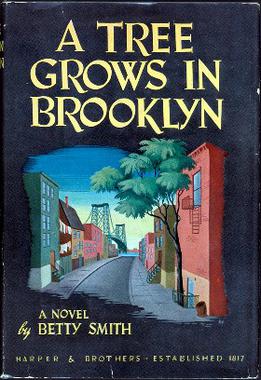
A Tree Grows in Brooklyn is a 1943 semi-autobiographical novel written by Betty Smith.

Brownstone is a brown Triassic–Jurassic sandstone that was historically a popular building material. The term is also used in the United States and Canada to refer to a townhouse clad in this or any other aesthetically similar material.

The building form most closely associated with New York City is the skyscraper, which has shifted many commercial and residential districts from low-rise to high-rise. Surrounded mostly by water, the city has amassed one of the largest and most varied collection of skyscrapers in the world.
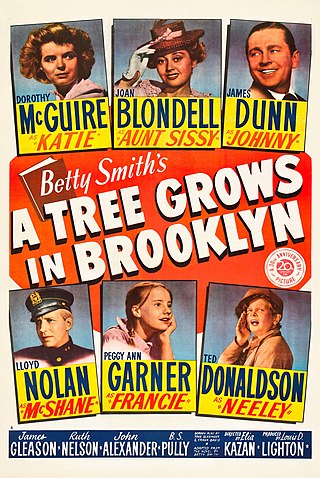
A Tree Grows in Brooklyn is a 1945 American drama film that marked the debut of Elia Kazan as a dramatic film director. Adapted by Tess Slesinger and Frank Davis from the 1943 novel by Betty Smith, the film focuses on an impoverished but aspirational, second-generation Irish-American family living in the Williamsburg neighborhood of Brooklyn, New York, in the early 20th century. Peggy Ann Garner received the Academy Juvenile Award for her performance as Francie Nolan, the adolescent girl at the center of the coming-of-age story. Other stars are Dorothy McGuire, Joan Blondell, Lloyd Nolan, Ted Donaldson, and James Dunn, who received the Academy Award for Best Supporting Actor for his portrayal of Francie's father.

Bridge Plaza is the northeastern corner of the downtown area of the New York City borough of Brooklyn. Its borders are Flatbush Avenue Extension and Manhattan Bridge on the west, Tillary Street on the south, and the Brooklyn-Queens Expressway (BQE) on the north and east.

Music Hall of Williamsburg is a New York City venue located at 66 North 6th Street in the Williamsburg neighborhood of Brooklyn. The venue is operated by The Bowery Presents, a group stemming from Bowery Ballroom. It has a capacity of 650 people and has shows on most nights of the week.
This is a timeline and chronology of the history of Brooklyn, New York. Brooklyn is the most populous of New York City's boroughs, and was settled in 1646.

Brooklyn Bowl is a music venue, bowling alley and restaurant in the Williamsburg neighborhood of Brooklyn, New York. Founded in 2009, it is located in the former Hecla Iron Works Building at 61 Wythe Avenue. It is known for its high-tech green construction and variety of musical acts. In 2013 Rolling Stone named Brooklyn Bowl the 20th best music club in the United States.

Glasslands Gallery was a music venue, dance club and art space in Williamsburg, Brooklyn. Glasslands was founded by Brooke Baxter and Rolyn Hu in 2006, as a relocation of Baxter’s earlier art space in the same building, Glass House Gallery. Hu and Baxter held the lease on the Glasslands space until 2012, when they made a turn key sale to Rami Haykal and Jake Rosenthal of PopGun presents, who had been managing bookings since 2009, and day-to-day operations since 2010. PopGun owned the business and lease for two years, until the venue was displaced to be converted into Vice Media‘s office headquarters. As a concert venue, Glasslands was one of the longest-running of several 2000s independent creative venue spaces in the vicinity of the Williamsburg waterfront, which included 285 KENT, Death By Audio, Secret Project Robot, Monster Island Basement, B.P.M., Live With Animals Gallery, the Rock Star Bar, and many others.
Yoel Goldman is an American real estate developer who founded the Brooklyn, New York-based development company, All Year Management.
Lit Lounge was a nightclub in the East Village neighborhood of Manhattan in New York City. The two-floor complex housed a concert venue, lounge, dance floor, and Fuse Gallery, an art exhibition space. Lit Lounge was noted as a major venue for New York City's hipster subculture in the mid- to late 2000s, particularly the indie rock and electroclash scene of the era.

